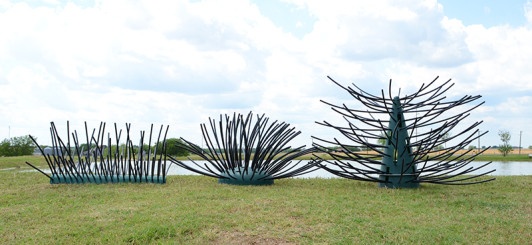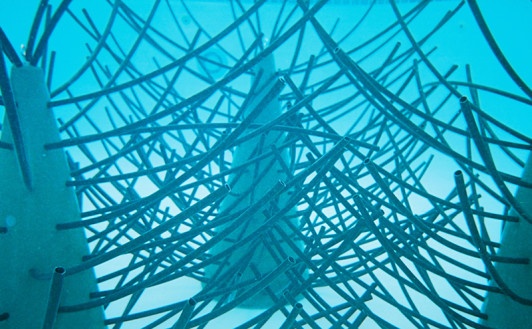The start of the Honey Hole line of artificial fish habitat began some 10 years ago in a swimming pool… but first I need to cover a little background. After performing many electroshock surveys, one fact was obvious; fish were found repeatedly crowded in or around some sort of cover. The healthiest bass populations always had two things in common; plenty of food and plenty of natural habitat.
Most often this was evident in a young lake, in the second to third year of its creation as habitat was newly submerged and forage populations were flourishing. Unfortunately as the lake continued to age much of the rich habitat deteriorated and both predator and forage populations suffered. Creating an economical solution to this problem takes us back to the swimming pool… I had made some prototypes and needed a clear picture of what they looked like underwater, so I asked a buddy if I could use his swimming pool.
The first attempt was good but, when I factored in the need for mass production and packaging, it fell short. Finally after a couple years of trials, the Honey Hole Tree and Shrub were born. Naming the product line needed to reflect it’s purpose, since at first glance people thought it was a unique piece of yard art.
When you think about a “honey hole”, the first thing that may come to mind is a great spot to fish, with lots of hungry, fat bass just waiting on your lure. This idea would be right on, but have you ever thought about what makes a “honey hole”? As the saying goes, 90 percent of the fish are in 10 percent of the water, so what is it about certain spots in a pond that are so attractive to fish? I created Pond King’s Honey Hole™ products with the idea that habitat provided several benefits to your pond’s ecosystem including stable surfaces for fish to lay eggs, and cover for smaller, juvenile fish to hide. This in turn, attracts larger fish like bass to the habitat where they hang out, waiting for their next meal. This keeps the bass well fed with minimum effort. At Pond King, the idea that this would produce nice-sized bass, seemed like common sense.
The Proof Is In The Pond
In the February 2015 Issue of Lone Star Outdoor News, Dr. Brian Graeb, a biologist from the University of South Dakota, published a study that emphasized the importance of habitat in growing 15lb plus bass. Dr. Graeb spoke on his findings, “We determined habitat was the most limiting factor in this lake. It was like we had a bunch of marathon runners and we wanted couch potatoes. The bass were skinny by having to swim so far.” Fish habitat allows bass to easily stalk their prey, reducing the amount of energy burned to feed, keeping them fat and happy. He continued, “The goal is to try and decrease fish activity, decrease their home range and increase consumption.” In some instances, pond owners attempt to create habitat using wood pallets, old Christmas trees, and other forms of brush that eventually need to be replaced. The study also addressed how this type of habitat had negative implications on growing fat bass. “After scanning the bottom of the lake, it was found the old structure had rotted away and bass were traveling so far to find food sources on what little structure remained.”

Pond King Honey Hole™ habitat is made with polyethylene, which is flexible, lightweight, and will not rot or deteriorate. Honey Hole™ products contain no toxic glue, are environmentally friendly, and best of all will never need to be replaced. Therefore, your bass will always have dependable habitat (aka their food source) near by.
So while the researchers found what they thought were “very unexpected results”, here at Pond King, we have been adding habitat to ponds and lakes for nearly a decade. We have maintained that the addition of habitat is a critical component of trophy bass management. It’s always nice to see science agree with common sense.
Shooting for double-digit bass? Check out our full line of Honey Hole™ artificial habitat products and get to growing your own couch potatoes!
Happy Fishing!
Brad Metzler, President




